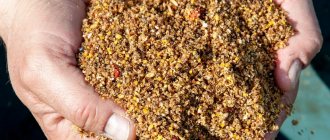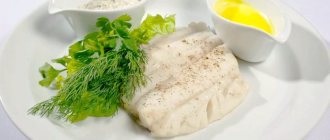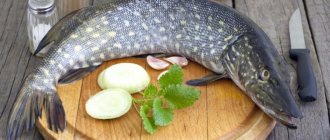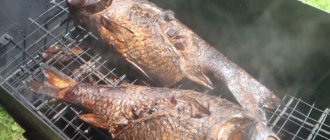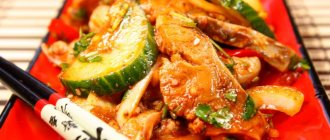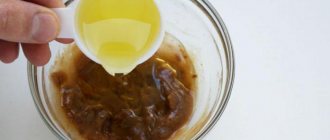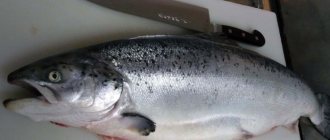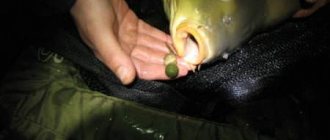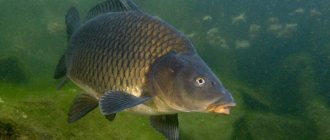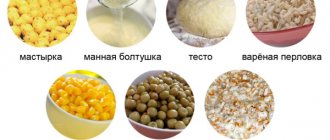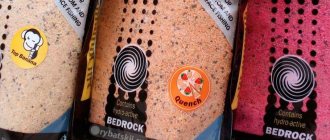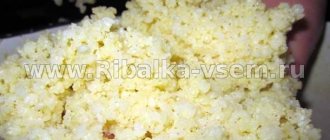What should bait for carp consist of?
Content
Bait for carp fishing is made from several ingredients. The correct choice of each component is the secret to successful fishing.
The best bait for carp is made from:
- main mixture - plant components that make up the bait base. Bulk mixtures or cereals are used, which the carp eats. Proper carp bait almost always contains: dry milk, crushed seeds, cereals, flour and dry flavorings;
- granules, they are also called pellets. Each manufacturer has its own understanding of which bait is best for carp, but the base most often used is: dry milk, meal from bones and fish trimmings, corn gluten, hemp, vitamin or mineral complexes. To enrich the bait with vitamins, oils from flax, soy or sunflower are added to the composition. Once in the water, the granules dissolve, forming a cloudy spot and creating an attractive aroma;
Every fisherman knows that bait is the key to success in any fishing
- boilies. The composition of bait for carp often includes boilies, which are traditionally used to catch carp and a number of other fish. Due to the large size of the balls, they are bypassed by various small things that prevent the fisherman from getting a good catch. Self-made groundbait mainly uses: flour, spices (sugar and salt) and flavorings;
- animal ingredients with flavorings. Their role is to awaken the appetite even in well-fed fish, its activity increases and vigilance decreases. The right flavors for bait can attract prey even from the opposite corner of the bait. The type of flavorings depends on the time of year. In hot weather, it is better to use vanilla, anise scents or other natural baits: additives with fruit and berry flavors. In cold weather, the best choice is maggots, bloodworms, and worms.
When making grain baits for carp fishing, it is customary to use essential oils; they are inexpensive, have a distinct smell and do not require preparation.
Carp loves corn, so its grains are the most common ingredients in the bait mixture. Corn attracts fish due to its taste and has a noticeable color; the grains are easy to detect even in muddy water. If you use bait for fishing with corn, the amount of grains should not exceed 60%, and preferably 50%.
Fishmeal and carp fishing
Right off the bat. Fishmeal attracts both freshwater and saltwater fish. From the Atlantic to the Mediterranean, from salmon to mullet, including white fish, everyone loves fishmeal! Having a pungent odor that can scare people away (you never know), fishmeal is very attractive to fish. And, of course, carp fishing is not complete without fishmeal.
The main advantage of fish meal is the high proportion of proteins and amino acids that fish need to build body cells (proteins) and their efficient functioning (amino acids). There is no better combination of them than in fishmeal. In addition, there are also minerals nearby that also have a positive effect on the well-being of the fish: iron, phosphorus and calcium.
How is fishmeal produced?
It is produced from those types of fish that are not in demand as food. In short, fishmeal is fish trimmings, a kind of bycatch that is not used for consumption and is a by-product of the fish processing industry.
But you should not think that bycatch or trimmings are some kind of low-quality or sick fish. A similar term refers to small species of fish with a large number of bones and a short life expectancy. So they are used for fishmeal. If consumption exceeds production volumes, herring is used for fishmeal.
Overview of the fishmeal market in Russia
The main source of fishmeal in Russia is pollock. The production process is quite complex and includes cooking, pressing, fire and steam drying, as well as grinding. To obtain one ton of flour, about 5 tons of raw materials are required. By the way, if you are interested, GOST 2116-2000 regulates the quality standard of fishmeal offered on the market in the Russian Federation.
The key problem for the production of fishmeal in our country is the lack of raw materials. A significant part of it is immediately exported, plus the aging fleet of ships and production equipment reduces labor productivity many times over. Especially when compared with the Scandinavian countries. At the moment, the demand of the Russian market is several times greater than the supply of domestic producers. Russia produces about 80 thousand tons of fishmeal, while the demand exceeds 500 thousand tons.
Please note that fishmeal is different from fishmeal. There are three groups: low protein (less than 50% protein), medium protein (more than 60% protein) and high protein (more than 70% protein). These types of flour differ greatly in quality and price. Some unscrupulous manufacturers often falsify fishmeal. In order to reduce the cost, or increase the price, they can add urea to it, or mix fishmeal with cheaper ones - meat and bone meal, soybeans, soybean sprat, bran, and so on.
Also, to avoid taxes and duties, many companies produce flour directly on ships and sell it to foreigners directly on the high seas.
Fishmeal and bait for carp fishing
It is very important to understand what kind of flour the manufacturer uses. Low, medium, or low protein. The closest producer of fishmeal to England or France (the leading countries in the production of boilies) is the Scandinavian countries. It is worth noting that their turnover may not be as enormous as that of Peru, but almost all Norwegian flour belongs to the high-protein class. Oh, and Peru is the world leader in fishmeal production. 20% of the world's flour comes from Peruvians.
In fact, there are many flour markers, but it is for making boilies that flour marked LT94 is rated highest. This is a high-protein flour with a protein content strictly above 70%. Moreover, its digestibility is as much as 94%. That is, it is guaranteed to start the dissolution process (read “work of boilies”) in absolutely any water.
That is why many manufacturing companies, such as Dynamite Baits, Fun Fishing, use exclusively this type of flour for their leading lines of boilies. Although there are a lot of options, here the guys keep the bar. Fan Fishing are generally true fans of LT94 and use it in almost all boilies except the budget Classic series.
Simple math
Now let's imagine that we have 1 office in Russia, and another office in London. We need to order fishmeal for the production of boilies. The distance between Oslo and London is 1726 km. This is exactly the way. Not a geometric line between two points. Namely, how much fishmeal needs to travel through transport in order for it to end up in the capital of England. Now let's look at the distance Oslo - Moscow. The route is 2,081 km, Oslo - St. Petersburg 1,357 km. You can simply add the distance to Moscow or St. Petersburg for other cities.
It seems like completely comparable distances. There are no problems here. Now we add the fact that Norway and England have a single economic space. The so-called European Economic Area, created on January 1, 1994 and providing for the free movement of goods, capital, services and people. The so-called “four freedoms” within the European Single Market. In other words, transporting goods from Oslo to London is the same as transporting it from Yekaterinburg to Moscow.
Now imagine the route from Norway to Russia. Your container or truck immediately falls into the red zone. Because you are importing goods that are subject to customs duties and fees. You can say that the same thing awaits ready-made boilies that will travel from England to Russia - that’s right. But keep in mind that an established procurement channel for the same Dynamite Bates already a priori reduces the cost of flour. Because it is supplied on an industrial scale and the buyer receives a wholesale discount.
By the way, if you’re interested, on the retail market in the UK, 1 kg of LT94 fishmeal straight from Norway costs 550 rubles at the current exchange rate, or for 6,750 rubles you can buy a 25 kg bag. We remind you that this is a high-protein flour with a protein content of 71%. Just for fun, try looking for something similar in retail in Russia. It will cost you a lot of work.
Let's also not forget about the embargo imposed by the Russian government on the import of products from Norway. That is, it has not been possible to import LT94 directly legally for the next one and a half to two years. Accordingly, it is also impossible to purchase it from us. Well, only if you don’t have access to the black market for fishmeal
